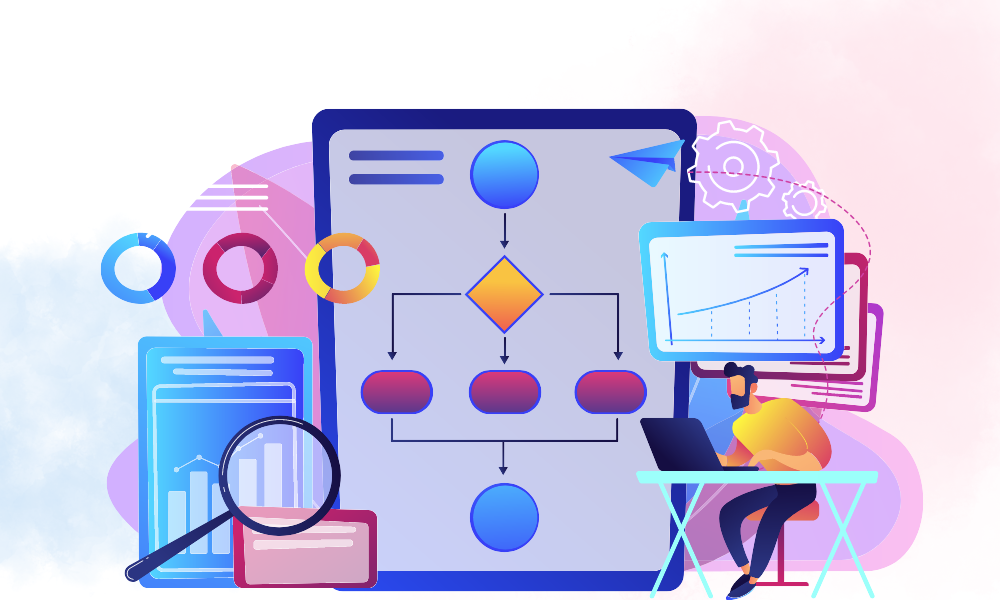Workflow Automation Trends and Insights for 2024.
You Can’t Afford To Overlook!
Share:

Workflow Automation Trends and Insights for 2024.
You Can’t Afford To Overlook!
Share:

Get to know about:
Stay Ahead of Competition with Automated Workflows
In today’s dynamic business environment, the integration of automation into operations has become essential for staying competitive. From streamlining processes to enhancing productivity, workflow automation is transforming businesses across industries. In this blog, we explore the adoption trends, the need for automation, its benefits, challenges, market statistics, and projections, along with future trends shaping the automation landscape.
Expediting Automation Initiatives for Future Readiness
More than one-third of businesses have embraced automation across five or more divisions, showcasing a widespread adoption of automated solutions. This proliferation signifies a fundamental shift towards leveraging technology to optimize workflows and drive organizational effectiveness across various functional areas.
Additionally, more than 80% of corporate executives report accelerating work process automation and expanding the use of remote workers, signaling a proactive approach towards future readiness. By embracing automation and flexible workforce strategies, organizations can adapt to evolving challenges, drive operational excellence, and thrive in an increasingly dynamic business landscape.
What is the need for workflow automation?
Reducing Labor Costs:
Automation software is increasingly recognized as a cost-effective solution for businesses looking to streamline their operations.
According to insights from business leaders, 31% of them acknowledge the significant impact of automation software in reducing labor costs.
By automating repetitive tasks and streamlining workflows, organizations can minimize the need for manual intervention, thereby reducing labor expenses and reallocating resources to more strategic initiatives.
Mitigating the Effects of Task-Switching:
Task-switching is a common phenomenon in today’s multitasking work environment. Employees often find themselves juggling multiple tasks simultaneously, leading to a loss of focus and productivity. Research indicates that task-switching can result in a productivity loss of up to 40%.
Automation software helps mitigate the effects of task-switching by automating repetitive tasks and allowing employees to focus their time and energy on more strategic activities. By streamlining workflows and reducing the need for manual intervention, automation software enables employees to work more efficiently and effectively.
Impact on Daily Workflows:
The impact of automation on daily workflows is profound. Approximately 70% business leaders reported, spending between 45 minutes to 3 hours of their workday on repetitive tasks. These tasks, while necessary, can be time-consuming and detract from more strategic initiatives.
By automating these repetitive tasks, organizations can free up valuable time for employees to focus on higher-value activities that drive business growth and innovation.
Employee and Leader Perspectives on Time Savings:
Both employees and company leaders recognize the potential time savings that automation can provide. Employees estimate that automating tasks could save them approximately 240 hours per year, while company leaders are even more optimistic, believing that automation could save them up to 360 hours per year.
These time savings translate into increased productivity, improved work-life balance, and greater opportunities for innovation and growth.
Time and Resource Wastage:
Office workers spend over 50% of their time manually searching for files, emphasizing the urgent need for automation to reduce inefficiencies.
Additionally, human error, responsible for 90% of accidents, underscores the importance of automated processes in risk mitigation.
Productivity and Cost Savings:
According to McKinsey and Company automation has the potential to boost global productivity growth by 0.8-1.4% annually, offering significant cost savings for businesses. By reducing operational expenses and labor costs, automation enables organizations to allocate resources towards innovation and growth initiatives.
Alignment Impact:
The lack of alignment significantly influences job outcomes for 97% of corporate executives, highlighting the crucial role of automation in fostering organizational cohesion.
Data Management:
With 85% of data being unstructured, automation is essential for effective data management, saving time and minimizing errors while enhancing decision-making processes.
Future of Workflow Automation:
Market Predictions: Gartner predicts that 69% of daily management tasks will be automated by 2024, indicating the pervasive nature of automation across organizational functions.
Economic Impact: Automation has the potential to bridge the economic growth gap in the world’s 20 largest nations by 2030, paving the way for inclusive growth and sustainable development.
The Impact of Automation Across Industries and Departments
From enhancing customer experiences to streamlining operations, automated processes are reshaping industries worldwide.
Let’s explore how different sectors are harnessing automation to drive innovation and propel their businesses forward.
Marketing Workflow Automation:
With 51% of companies leveraging marketing automation, conversion rates have increased for 77% of marketers, demonstrating the efficacy of automation in driving marketing outcomes.
Healthcare: Leading the Digital Revolution
The healthcare sector is at the forefront of embracing digital transformation. According to the HIMSS Future of Healthcare Report, nearly 80% of healthcare providers aim to significantly increase their investments in digital healthcare solutions over the next five years.
This surge in expenditure reflects the industry’s commitment to leveraging automation for improving patient care, optimizing administrative processes, and enhancing overall efficiency.
Financial Sector: Maximizing Cost Savings
Experts estimate that financial automation can yield up to 90% in operational cost savings. By automating routine tasks such as data entry, transaction processing, and compliance reporting, financial institutions can reallocate resources towards strategic initiatives and enhance their competitive edge in the market.
Retail Industry: Driving Growth Through Automation
According to McKinsey, investments in retailer automation are poised to drive substantial industry growth. The warehouse automation market is projected to reach $51 billion by 2030, with a staggering compound annual growth rate (CAGR) of 23%.
This surge in automation adoption underscores the retail sector’s commitment to optimizing supply chain management, improving inventory accuracy, and meeting evolving consumer demands.
Engineering and IT: Powering Automation Initiatives
The engineering and IT departments play a pivotal role, handling approximately 40% of an organization’s automation efforts. With their expertise in developing and implementing cutting-edge technologies, these departments are instrumental in optimizing workflows and enhancing productivity across the board.
Streamlining Recruitment Processes
Interestingly, one in ten business leaders agrees that automation can streamline hiring processes. By automating repetitive tasks such as resume screening, interview scheduling, and candidate communication, organizations can expedite recruitment cycles, minimize human bias, and attract top talent more efficiently.
Enhancing Customer Service Through Automation
Feedback gathering is increasingly automated across organizations, with 65% of customer service experts acknowledging its efficacy. Additionally, 37% of IT leaders report having automated customer service departments within their companies.
By leveraging automation tools such as chatbots, sentiment analysis, and automated ticketing systems, businesses can enhance customer satisfaction, streamline support processes, and gain valuable insights into consumer preferences.
Meeting Rising Demand in Healthcare Administration
The Bureau of Labor Statistics projects an 18% growth in the need for healthcare administration personnel between 2018 and 2028.
This uptrend underscores the increasing reliance on automated systems to manage patient records, streamline billing processes, and optimize resource allocation within healthcare organizations.
Conclusion
As businesses navigate an increasingly complex and competitive landscape, the adoption of workflow automation emerges as a strategic imperative for driving efficiency, innovation, and growth.
By embracing automation technologies and fostering a culture of continuous learning and adaptation, businesses can harness the full potential of automation to thrive in the digital age.
Related Topics
Automate your workflows easily.
Tailored workflows for all your unique business processes.










